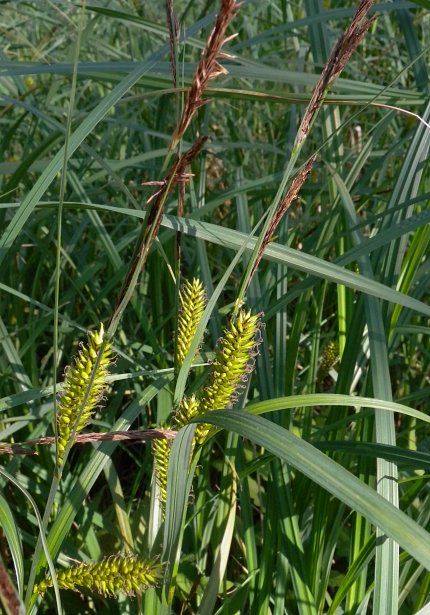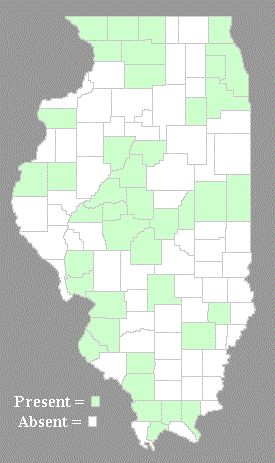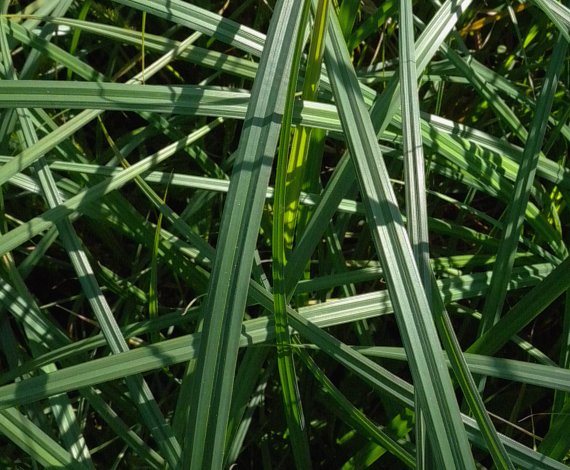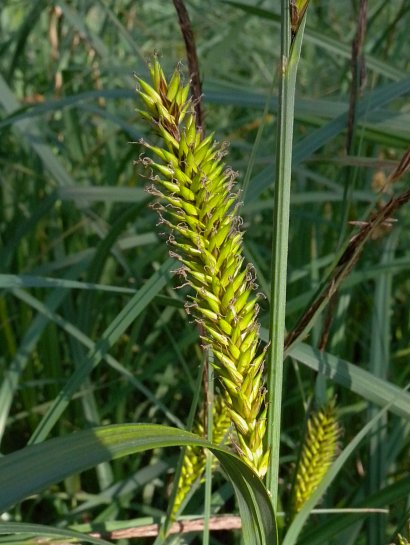
Each fertile culm terminates in an inflorescence consisting of 2-4 pistillate (female) spikelets and 2-5 staminate (male) spikelets; an inflorescence is typically ¾-2' long. In each inflorescence, the pistillate spikelets are located below the staminate spikelets. Both types of spikelets are organized around a central stalk; they are ascending to erect and relatively straight. The female spikelets are 2-3½" long and cylindrical in shape (about 1.5 cm. across); the perigynia of these spikelets are packed densely together and they are slightly ascending to ascending. The female spikelets have short stiff peduncles up to 1" long or they are nearly sessile. The perigynia (sacs covering the achenes) are 5-7 mm. long and 1.5-2.5 mm. across; they are lanceoloid in shape and slightly flattened, tapering to a beak with a pair of short teeth at its apex. These teeth are about 0.5 mm. in length. Perigynia are glabrous and they have several longitudinal veins that are relatively conspicuous.
 Immature perigynia are light
green, but
they later become yellow and finally turn brown at maturity. The
pistillate scales are shorter than the perigynia; they are
lanceolate-ovate in shape, tapering to an acute tip that is often
awned. The scales initially have green central veins and membranous
margins; later they become brown or black. The staminate
spikelets are
1½-3½" long and very narrow (about 5 mm. across); they soon turn brown.
The uppermost staminate spikelet has a short peduncle up to 3" long,
while the remaining staminate spikelets are sessile (or nearly so). At
the bases of these spikelets are leafy bracts; the lowest bract is
large and leafy in appearance, while the remaining bracts become
progressively shorter and more narrow in size as they ascend the
central stalk of the inflorescence. The blooming period is late spring
to early summer (rarely later), lasting about 1-2 weeks. The florets of
the spikelets are cross-pollinated by the wind. Afterwards, mature
perigynia disarticulate from their spikelets; they are somewhat
inflated and can be distributed to new areas by water, carrying their
achenes with them. Each perigynium contains a single achene;
the achenes are 2.0-2.5 mm. long, broadly ellipsoid in shape,
bluntly 3-angled, and glabrous. The root system is fibrous and
long-rhizomatous. This sedge often forms large clonal colonies of
plants.
Immature perigynia are light
green, but
they later become yellow and finally turn brown at maturity. The
pistillate scales are shorter than the perigynia; they are
lanceolate-ovate in shape, tapering to an acute tip that is often
awned. The scales initially have green central veins and membranous
margins; later they become brown or black. The staminate
spikelets are
1½-3½" long and very narrow (about 5 mm. across); they soon turn brown.
The uppermost staminate spikelet has a short peduncle up to 3" long,
while the remaining staminate spikelets are sessile (or nearly so). At
the bases of these spikelets are leafy bracts; the lowest bract is
large and leafy in appearance, while the remaining bracts become
progressively shorter and more narrow in size as they ascend the
central stalk of the inflorescence. The blooming period is late spring
to early summer (rarely later), lasting about 1-2 weeks. The florets of
the spikelets are cross-pollinated by the wind. Afterwards, mature
perigynia disarticulate from their spikelets; they are somewhat
inflated and can be distributed to new areas by water, carrying their
achenes with them. Each perigynium contains a single achene;
the achenes are 2.0-2.5 mm. long, broadly ellipsoid in shape,
bluntly 3-angled, and glabrous. The root system is fibrous and
long-rhizomatous. This sedge often forms large clonal colonies of
plants.Cultivation: The preference is full or partial sun, wet conditions, and soil containing mud, silt, or calcareous sand. This large sedge can spread aggressively by means of its rhizomes. While it can tolerate light shade, this sedge may not produce any spikelets. Seasonal flooding is readily tolerated.
Range & Habitat: The native Lake Sedge is occasional in central and northern Illinois, becoming less common in the southern section of the state. Habitats include depressions in floodplain woodlands, flatwoods, soggy thickets, wet black soil prairies, wet dolomite prairies, prairie swales, typical marshes and sandy marshes, typical swamps and sandy swamps, seeps and fens, sedge meadows, and borders of ponds or small lakes. Sometimes Lake Sedge is the dominant sedge in these habitats. It is not uncommon to find this sedge growing in shallow water.
Faunal Associations: Like other wetland sedges (Carex spp.), Lake Sedge attracts many insects that feed on its foliage, stems, and seeds. These species include several aquatic leaf beetles (especially Plateumaris spp.), Sphenophorus costicollis (Sedge Billbug), many aphids (Rhopalosiphum spp., Thripsaphis spp., etc.), several leafhoppers (especially Cosmotettix spp.), the spittlebug Philaenus parallelus, the seed bugs Cymus angustatus and Oedancala dorsalis, the plant bugs Mimoceps insignis and Teratocoris discolor, stem-boring larvae of the flies Cordilura varipes and Loxocera cylindrica, sedge grasshoppers (Stethophyma spp.), caterpillars of several skippers (especially Euphyes spp.), caterpillars of the butterflies Satyrodes appalachia (Appalachian Brown) and Satyrodes eurydice (Eyed Brown), and caterpillars of several moths. For a more complete list of these species, see the Insect Table.

Vertebrate animals also rely on Lake Sedge and other sedges as sources of food. Many waterfowl, rails, and songbirds eat the seeds or spikelets of wetland sedges (see Bird Table). Among mammals, muskrats occasionally eat the roots and young sprouts, while deer browse sparingly on the foliage. Such turtles as Chelydra serpentina (Snapping Turtle) and Kinosternum subrubrum (Eastern Mud Turtle) also eat the seeds or young foliage to a limited extent. Because this large sedge often forms sizable colonies, it provides excellent cover for many kinds of insects, birds, snakes, and other kinds of wetland wildlife. During the drier parts of the year, deer use colonies of this sedge as 'bedding' for the night, leaving behind flattened culms and leaves.
Photographic Location: An open sandy swamp at the Indiana Dunes State Park in NW Indiana.

Comments: This is one of the largest sedges (Carex spp.) and it has unusually long leaves that are up to 20 mm. across. These unusually wide leaves help to distinguish Lake Sedge from similar wetland sedges. It is very similar in appearance to another large sedge, Carex hyalinolepis (Ditch Sedge), which has equally broad leaves. This latter sedge is found primarily in southern Illinois. Ditch Sedge differs from Lake Sedge by having having basal leaves with significant blades and its perigynia have less conspicuous longitudinal veins. It is also less likely to be reddish purple at the bases of its culms. Other similar wetland sedges differ by having more narrow leaves (less than 12 mm. across) or longer teeth on their perigynia (1 mm. in length or more). Some of these sedges also differ by having hairy leaves (whether sheaths or blades) and hairy perigynia. Lake Sedge can be considered one of the most imposing sedges that can dramatically transform the appearance of wetland when it is introduced. It is useful for the control of water erosion along ponds or slow-moving rivers.